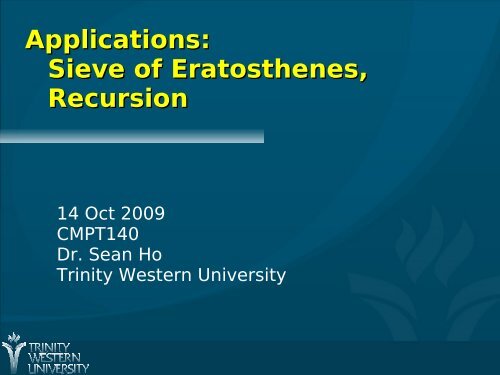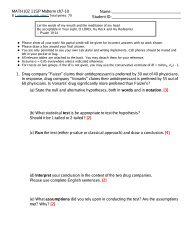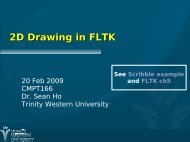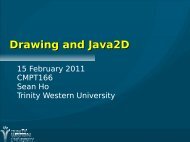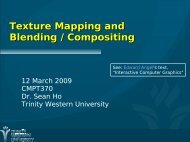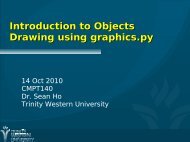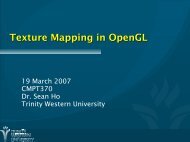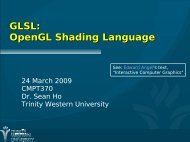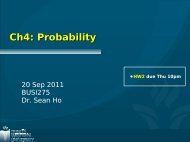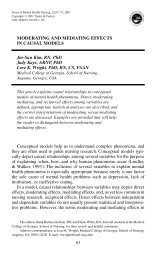Applications: Sieve of Eratosthenes, Recursion - seanho
Applications: Sieve of Eratosthenes, Recursion - seanho
Applications: Sieve of Eratosthenes, Recursion - seanho
Create successful ePaper yourself
Turn your PDF publications into a flip-book with our unique Google optimized e-Paper software.
<strong>Applications</strong>:<br />
<strong>Sieve</strong> <strong>of</strong> <strong>Eratosthenes</strong>,<br />
<strong>Recursion</strong><br />
14 Oct 2009<br />
CMPT140<br />
Dr. Sean Ho<br />
Trinity Western University
<strong>Sieve</strong> <strong>of</strong> <strong>Eratosthenes</strong><br />
Problem: list all the prime numbers between 2<br />
and some given big number.<br />
● You had a homework that was similar: test if<br />
a given number is prime, and list its factors<br />
● How did you solve that?<br />
Procedure is_prime() (pseudocode):<br />
Iterate for factor in 2 .. sqrt(n):<br />
If (n % factor == 0), then<br />
We've found a factor!<br />
But this is wasteful: really only need to test<br />
prime numbers for potential factors<br />
CMPT140: <strong>Sieve</strong> <strong>of</strong> <strong>Eratosthenes</strong> 14 Oct 2009<br />
2
Listing all primes<br />
We could tackle this problem by repeatedly<br />
calling is_prime() on every number in turn:<br />
for num in range(2, max):<br />
if is_prime(num) ...<br />
But this could be really slow if max is big<br />
Is there a smarter way to eliminate non-prime<br />
(composite) numbers?<br />
CMPT140: <strong>Sieve</strong> <strong>of</strong> <strong>Eratosthenes</strong> 14 Oct 2009<br />
3
<strong>Sieve</strong> <strong>of</strong> <strong>Eratosthenes</strong><br />
The sieve works by a process <strong>of</strong> elimination: we<br />
eliminate all the non-primes by turn:<br />
1 2 3 4 5 6 7 8 9 10<br />
11 12 13 14 15 16 17 18 19 20<br />
21 22 23 24 25 26 27 28 29 30<br />
31 32 33 34 35 36 37 38 39 40<br />
41 42 43 44 45 46 47 48 49 50<br />
51 52 53 54 55 56 57 58 59 60<br />
61 62 63 64 65 66 67 68 69 70<br />
71 72 73 74 75 76 77 78 79 80<br />
81 82 83 84 85 86 87 88 89 90<br />
91 92 93 94 95 96 97 98 99 100<br />
CMPT140: <strong>Sieve</strong> <strong>of</strong> <strong>Eratosthenes</strong> 14 Oct 2009<br />
4
Prime sieve: pseudocode<br />
1) Create an array <strong>of</strong> booleans and set them all to<br />
true at first. (true = prime)<br />
2) Set array element 1 to false. Now 2 is prime.<br />
3) Set the values whose index in the array is a<br />
multiple <strong>of</strong> the last prime found to false.<br />
4) The next index where the array holds the value<br />
true is the next prime.<br />
5) Repeat steps 3 and 4 until the last prime found<br />
is greater than the square root <strong>of</strong> the largest<br />
number in the array.<br />
CMPT140: <strong>Sieve</strong> <strong>of</strong> <strong>Eratosthenes</strong> 14 Oct 2009<br />
5
Prime sieve: Python code<br />
"""Find all primes up to a given number, using<br />
<strong>Eratosthenes</strong>' prime sieve."""<br />
import math<br />
# sqrt<br />
size = input("Find all primes up to: ")<br />
# Initialize: all numbers except 0, 1 are prime<br />
primeFlags = range(size+1) # so pF[size] exists<br />
for num in range(size+1):<br />
primeFlags[num] = True<br />
primeFlags[0] = False<br />
primeFlags[1] = False<br />
CMPT140: <strong>Sieve</strong> <strong>of</strong> <strong>Eratosthenes</strong> 14 Oct 2009<br />
6
Prime sieve: Python code (p.2)<br />
# Computation: eliminate all non-primes<br />
for num in range(2, int(math.sqrt(size))+1):<br />
if primeFlags[num]:<br />
# got a prime<br />
# Eliminate its multiples<br />
for multiple in range(num**2, size+1, num):<br />
primeFlags[multiple] = False<br />
# Output<br />
print "Your primes, sir/madam:",<br />
for num in range(2, size+1):<br />
if primeFlags[num]:<br />
print num,<br />
http://twu.<strong>seanho</strong>.com/python/primesieve.py<br />
CMPT140: <strong>Sieve</strong> <strong>of</strong> <strong>Eratosthenes</strong> 14 Oct 2009<br />
7
<strong>Recursion</strong><br />
<strong>Recursion</strong> is when a function invokes itself<br />
Classic example: factorial (!)<br />
● n! = n(n-1)(n-2)(n-3) ... (3)(2)(1)<br />
● 0! = 1<br />
Compute recursively:<br />
● Inductive step: n! = n*(n-1)!<br />
● Base case: 0! = 1<br />
Inductive step: assume (n-1)! is calculated<br />
correctly; then we can find n!<br />
Base case is needed to tell us where to start<br />
CMPT140: <strong>Sieve</strong> <strong>of</strong> <strong>Eratosthenes</strong> 14 Oct 2009<br />
8
factorial() in Python<br />
def factorial(n):<br />
"""Calculate n!. n should be a positive<br />
integer."""<br />
if n == 0:<br />
return 1<br />
else:<br />
return n * factorial(n-1)<br />
# base case<br />
# inductive step<br />
Progress is made each time: factorial(n-1)<br />
Base case prevents infinite recursion<br />
What about factorial(-1)? Or factorial(2.5)?<br />
CMPT140: <strong>Sieve</strong> <strong>of</strong> <strong>Eratosthenes</strong> 14 Oct 2009<br />
9
The call stack<br />
When a program is running, an area<br />
<strong>of</strong> memory is set aside to store local<br />
variables, the state <strong>of</strong> the program,<br />
etc.<br />
When a procedure is invoked, the<br />
calling context is saved, and a new<br />
chunk <strong>of</strong> memory is allocated for the<br />
procedure to use: its stack frame<br />
When the procedure finishes, its<br />
frame is released and control goes<br />
back to the calling context<br />
The stack pointer keeps track <strong>of</strong><br />
what frame is currently running<br />
stack<br />
pointer<br />
math.sin()<br />
calc_volume()<br />
__main__<br />
CMPT140: <strong>Sieve</strong> <strong>of</strong> <strong>Eratosthenes</strong> 14 Oct 2009<br />
10
Call stack for recursion<br />
def factorial(n):<br />
"""Compute the factorial <strong>of</strong> a<br />
positive integer."""<br />
if n == 0:<br />
else:<br />
return 1<br />
return n*factorial(n-1)<br />
If there were any local variables,<br />
each frame would have its own<br />
instance <strong>of</strong> the local variables<br />
When an error (exception)<br />
happens, IDLE shows a<br />
backtrace: part <strong>of</strong> the call stack<br />
stack<br />
pointer<br />
factorial(0)<br />
factorial(1)<br />
factorial(2)<br />
factorial(3)<br />
__main__<br />
CMPT140: <strong>Sieve</strong> <strong>of</strong> <strong>Eratosthenes</strong> 14 Oct 2009<br />
11
<strong>Recursion</strong> example: Fibonacci<br />
Fibonacci sequence: 1, 1, 2, 3, 5, 8, 13, 21, 34,..<br />
● Each number is the sum <strong>of</strong> the two previous<br />
def fibonacci(n):<br />
"""Compute the n-th Fibonnaci number.<br />
pre: n should be a positive integer.<br />
"""<br />
if n == 0 or n == 1:<br />
return 1<br />
else:<br />
# base case<br />
# inductive step<br />
return fibonacci(n-2) + fibonacci(n-1)<br />
● Note: very inefficient algorithm!<br />
CMPT140: <strong>Sieve</strong> <strong>of</strong> <strong>Eratosthenes</strong> 14 Oct 2009<br />
12
Computing & Society Paper<br />
Computing scientist as Godly Christian Leader:<br />
● Not just knowledge about tools, but<br />
● Wisdom <strong>of</strong> how to use tools<br />
To serve others and<br />
To give glory to God<br />
Write a short essay on a topic <strong>of</strong> your choosing<br />
about computers and society:<br />
~ 5 pages typed double-spaced 12pt 1in margins<br />
Submit half-page topic by Fri 6Nov<br />
Paper due near end <strong>of</strong> semester (Wed 2Dec)<br />
●<br />
Electronic submission (email, eCourses)<br />
CMPT140: <strong>Sieve</strong> <strong>of</strong> <strong>Eratosthenes</strong> 14 Oct 2009<br />
13
Sample paper topics<br />
Censorship and free speech<br />
● Pornography, gambling, hate groups, etc.<br />
Violence in video games (Columbine etc.)<br />
Privacy: online banking, ID theft, etc.<br />
Blogs: effect on politics, social interaction, etc.<br />
File sharing: Napster, Gnutella, etc.<br />
Artificial intelligence: the nature <strong>of</strong> sentience<br />
Online dating (e.g. eHarmony): pros/cons<br />
Equity <strong>of</strong> access / rural digital divide<br />
● ...... or come up with your own topic!<br />
CMPT140: <strong>Sieve</strong> <strong>of</strong> <strong>Eratosthenes</strong> 14 Oct 2009<br />
14
Tips for essay writing<br />
Your essay should be a position paper:<br />
● Topic should have at least two sides (e.g. pro/con)<br />
● You should state (in the introductory paragraph)<br />
what your position is (thesis)<br />
● You should have at least 2-3 points, each,<br />
both for and against your position<br />
It is not necessary to rebut every point that<br />
contradicts your position:<br />
Be honest about faults/limitations <strong>of</strong> your thesis<br />
● Summary intro/conclusion paragraphs<br />
● Proper English (spelling, grammar) is important!<br />
CMPT140: <strong>Sieve</strong> <strong>of</strong> <strong>Eratosthenes</strong> 14 Oct 2009<br />
15
TODO<br />
HW3 due Mon<br />
● Ch3 and mostly Ch4<br />
Lab3 due next week Wed/Thu<br />
● Full lab write-up required!<br />
Use “Lab Template” on course webpage<br />
CMPT140: <strong>Sieve</strong> <strong>of</strong> <strong>Eratosthenes</strong> 14 Oct 2009<br />
16


